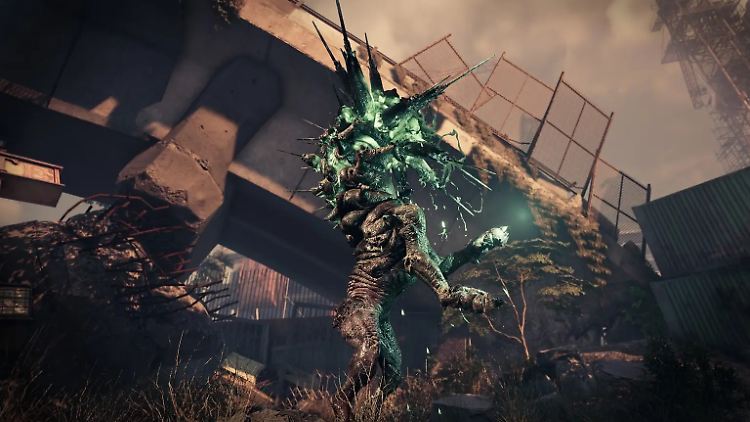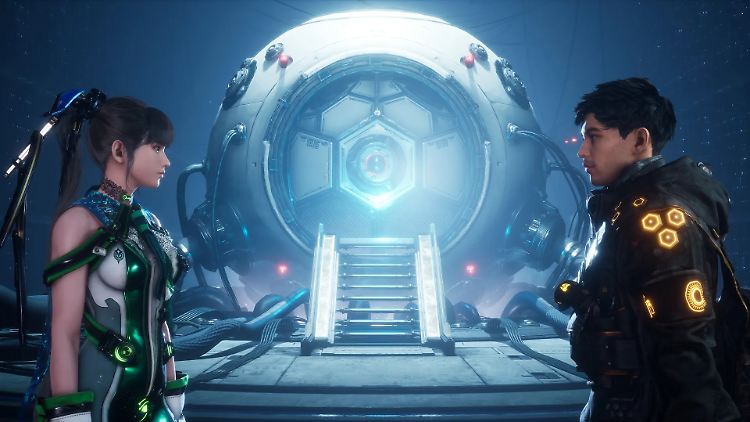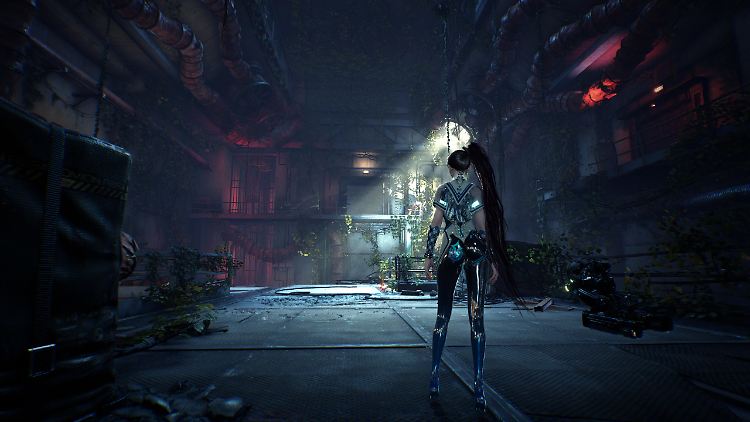The South Korean studio Shift Up actually only develops mobile games with simple mechanics and characters in skimpy outfits. Now it is supposed to bring a serious action game to market. Unfortunately, the project is a flop – despite having a great role model.
The following irony: A studio that has so far only been known for ripping off teenagers' money with anime-style pilfering mobile games is suddenly supposed to develop an action epic for the Playstation 5 for industry giant Sony. Now the studio in question can go above and beyond and turn the video game world on its head. It's supposed to happen. But “Stellar Blade” by Shift Up, more product than work, turns out to be a sad and fairly predictable punch line, our tester finds.


The monsters are certainly impressive.
(Photo: Screenshot/Shift Up)
Long before its release, “Stellar Blade” is already causing a lot of discussion. The portrayal of the female characters, especially the protagonist, is sparking a sexism debate. While there are already many games that have said goodbye to over-sexualized female bodies and twisted beauty ideals, such as “Last of Us 2,” “Stellar Blade” is taking a step back, meaning that women with anatomically questionable curves and squishy outfits flik-flake across battlefields and blast meaningful lines of dialogue at their companions.
To defend Shift Up: The studio has never done anything else. Everything the developer has created is more like the masturbation fantasies of a weird 13-year-old than a serious video game world. Nevertheless, the studio is free to choose how it presents itself; what matters is whether the game is good. And yes, while other games by the developer are very reduced in terms of graphics and gameplay, “Stellar Blade” offers a modern look, something like a plot and a real combat system. But none of it is good.
Lame story
Starting with the plot. After losing a war with the Naytibas, monstrous creatures with a monstrous urge for destruction, people flee into space. Protagonist Eve is now supposed to return to Earth, free the planet from the plague and make it habitable again. The parallels to “Nier: Automata” were already apparent in advance, an action game in which robots drive people off Earth and the protagonists set out in the name of humanity to… the rest should be clear.


There's a strange dress code in “Stellar Blade”.
(Photo: Screenshot/Stellar Blade)
Creative Director Hyung-Tae Kim makes no secret of his proximity, speaking openly in interviews about the inspiration he drew from “Nier: Automata”. The only problem is that the spiritual father is characterized by a nuanced story, existentialist questions and clever antimilitarism. “Stellar Blade” occasionally tries to do the same, but regularly stumbles into the phrase jar. Kim has scraped off the ideological critique of the original to create a depoliticized “Nier: Automata” – with more bare skin.
Lame game mechanics
In terms of the game mechanics, things look better at first glance. Eve controls smoothly and the fights against the monsters, which are sometimes obviously inspired by horror classics such as “Silent Hill” and “The Forest”, feel powerful. If Eve plows through enemies with her sword, it bangs; if she shoots from a distance, it bangs. Timing-based actions such as parrying and dodging not only provide dynamism, but also require a bit of skill. Mistakes are often punished with death. The fights are difficult, but far from the nerve-racking “Souls” series. Of course, there is also a touch of progression in the form of talent trees that expand the range of attacks. “Stellar Blade” therefore meets the minimum standards of a modern action game. But that's exactly where the catch lies.
There is a lack of original ideas. Instead, Shift Up takes functions that other games have implemented much better, such as the perfect parry in “Sekiro: Shadows Die Twice”, and then throws them together without much care. Everything works, but nothing really works well. The intense fights lose their appeal over time, the block-parry reaction tests wear out pretty quickly, and are also erratic – sometimes the time window is huge, sometimes tiny. There is simply a lack of depth. “Stellar Blade” is a medley of all the hits of the last few years, yes, but it is sung out of tune.
Lame game world
There is nothing unique to discover within the game world. There are destroyed buildings everywhere with ivy winding up, barren deserts, a bit of grey-blue water, lots of dilapidated industrial buildings, really everything is completely lifeless. “Stellar Blade” seems to follow a truism: if the landscapes are dead and the houses are empty and crooked, then it must be a dystopia.


Everything is mostly grey and gloomy.
(Photo: Screenshot/Stellar Blade)
It's a shame, Shift Up made it easy for itself. The studio dispenses with an open-world corset that forces developers to create a completely coherent game world. But the partially open areas are completely devoid of original design ideas, which becomes clear after the fifth stressful search for a switch, lever or access card to advance. Everything looks the same and is so dull that the urge to explore gets lost somewhere in the grey dusty desert. The question of what life might have looked like before never arises. But there is an answer to that, nonetheless – and this not only shows a lack of ingenuity, but also a technophile ideology.
Even before the monsters appeared, climate change was pushing the planet to its limits. But before rising heat, increasing UV radiation and acidified waters could wipe out all life, a company used genetic interventions to make people much more resilient. Openness to technology and the pursuit of innovation turned out to be the salvation, a vision in the spirit of Elon Musk. As if that wasn't enough, there is also over-the-top militarism.
Lame war propaganda
“Stellar Blade” draws on the worn-out image of a just war. The monsters are vaguely reminiscent of humanoid beings, but their combat-oriented design, such as chainsaw heads and sword arms, makes them pure killing machines with no motives. Of course, they have to be fought, if only to save humanity, the planet, and so on.
Years ago, “Nier Automata” showed that things can be done differently. The supposedly evil robots are designed to be cute with cute spherical bodies, some even call themselves pacifists. Over time, the boundaries between attacker and attacked become blurred and it becomes unclear to the players and the protagonists why they are actually fighting. Several main characters with multiple perspectives also prevent players from identifying with one character. In “Nier Automata” there are neither heroes nor good and evil; in “Stellar Blade” there is a heroine and an enemy.
It's not bad that Shift Up delivers ideological rubbish and borrows heavily from a number of games. In the cultural sector, the latter is completely normal; after all, there's a little Tolkien behind every fantasy epic, and Gibson behind every cyber dystopia. In video games, borrowings are even necessary. With every new and successful mechanic, the repertoire grows, allowing games to be made even more varied, more immersive, and even better. “Stellar Blade,” however, just borrows without making anything of it. No, it lacks its own ideas, it lacks depth, it's trash, not far from Shift Up's smartphone madness.


